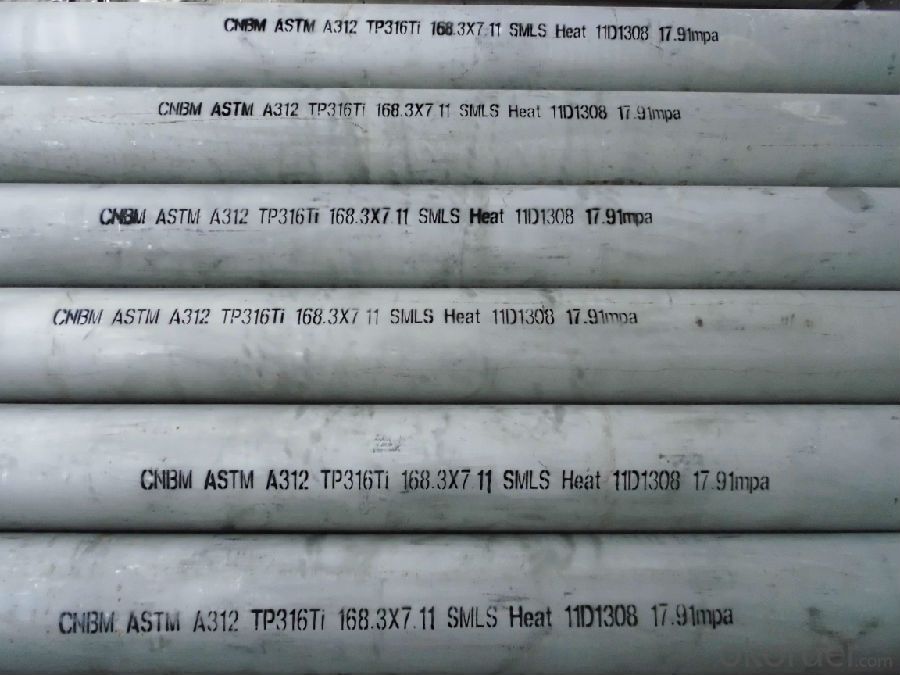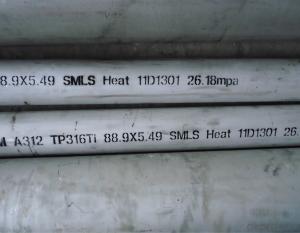Stainless steel pipe 316Ti 3
- Loading Port:
- China Main Port
- Payment Terms:
- TT OR LC
- Min Order Qty:
- -
- Supply Capability:
- -
OKorder Service Pledge
OKorder Financial Service
You Might Also Like
316Ti stainless steel plate is the addition of Ti in SUS316 steel can improve the resistance to intergranular corrosion resistance.


The chemical composition of 316Ti stainless steel:
C (%): less than 0.08
Si (%): less than 1
Mn (%): less than 2
P (%) is less than or equal to: 0.045
S (%) is less than or equal to 0.03
Cr (%): 16 ~ 18
Ni (%): 10 ~ 14
Mo (%): 2 ~ 3
other (%):
5 (C+N) = Ti = 0.70, N = 0.10
The mechanical properties of 316Ti stainless steel:
YS (Mpa) = 205 TS (Mpa) = 520 EL (%) is more than or equal to 40 Hv 200 degrees
- Q:Can stainless steel pipes be pickled and passivated?
- Yes, stainless steel pipes can be pickled and passivated. Pickling is a process that removes impurities and scale from the surface of stainless steel, while passivation is a treatment that forms a protective oxide layer on the surface to enhance corrosion resistance. This process is commonly used in industries such as oil and gas, chemical, and food processing to ensure the cleanliness and longevity of stainless steel pipes. Pickling and passivation can be done using a variety of acidic solutions and techniques, depending on the specific requirements of the pipes and the desired outcome.
- Q:Can stainless steel pipes be used for firefighting systems?
- Yes, stainless steel pipes can be used for firefighting systems. Stainless steel is a durable and corrosion-resistant material, making it suitable for such applications where durability and resistance to heat and pressure are required.
- Q:Stainless steel pipe welding interface leakage, how can we not leak?
- Protection gas flow, current and voltage should be chosen according to process;
- Q:Can stainless steel pipes withstand high temperatures?
- Yes, stainless steel pipes can withstand high temperatures due to their excellent heat resistance properties.
- Q:What is the difference between 304Cb and 316Cb stainless steel pipes?
- The main difference between 304Cb and 316Cb stainless steel pipes lies in their chemical composition and their respective properties. 304Cb stainless steel is an austenitic stainless steel alloy that contains chromium and nickel. It also has a small amount of niobium, which enhances its resistance to intergranular corrosion. This makes 304Cb stainless steel pipes suitable for a wide range of applications, including food processing, chemical and petrochemical industries, and architectural purposes. On the other hand, 316Cb stainless steel is also an austenitic stainless steel alloy that contains chromium and nickel. However, it has a higher percentage of molybdenum, which gives it superior resistance to corrosion and pitting in chloride environments. This makes 316Cb stainless steel pipes ideal for applications where exposure to saltwater or other corrosive substances is common, such as marine environments or coastal areas. In summary, while both 304Cb and 316Cb stainless steel pipes are excellent choices for various applications, 316Cb stainless steel offers better corrosion resistance in chloride environments due to its higher molybdenum content. Depending on the specific needs and environment of the application, one may be more suitable than the other.
- Q:What is the difference between seamless and submerged arc welded stainless steel pipes?
- The main difference between seamless and submerged arc welded stainless steel pipes lies in the manufacturing process. Seamless stainless steel pipes are produced without any welding seam, resulting in a smoother and more uniform surface. On the other hand, submerged arc welded stainless steel pipes are created by welding strips of stainless steel using an electric arc submerged in a flux. This process may leave a visible welding seam on the surface. Overall, seamless pipes offer better corrosion resistance and higher strength, while submerged arc welded pipes are typically more cost-effective and suitable for applications with lower pressure requirements.
- Q:How do you calculate the wall thickness for stainless steel pipes under external pressure?
- When calculating the wall thickness for stainless steel pipes under external pressure, various factors such as material properties, design codes, and applied external pressure must be taken into account. Here is a general method for calculating the wall thickness: 1. Identify the design pressure: Begin by determining the external pressure that the stainless steel pipe will experience. This pressure may be caused by factors like fluid flow, environmental conditions, or operational requirements. 2. Determine the properties of the material: Stainless steel pipes come in different grades, each with its own mechanical properties. Consult the material specifications to find the values for the yield strength (Sy) and ultimate tensile strength (Su) of the specific stainless steel grade being used. 3. Establish the allowable stress: The allowable stress (Sa) is the maximum stress that the material can handle under the given conditions. This information is usually provided by design codes or standards like ASME B31.3 for process piping or ASME Section VIII for pressure vessels. 4. Calculate the thickness for design pressure: Use the following formula to calculate the thickness required for design pressure (t): t = (P * D) / (2 * Sa) P represents the design pressure and D is the outside diameter of the stainless steel pipe. 5. Determine the corrosion allowance: Since stainless steel is prone to corrosion, it is important to consider a corrosion allowance to ensure the pipe's longevity. The design codes or industry standards typically specify the corrosion allowance. 6. Calculate the final wall thickness: Add the corrosion allowance to the thickness calculated for design pressure in step 4 to obtain the final wall thickness. It is important to note that this is a general method, and specific design codes or standards may have additional requirements or factors to consider. Therefore, it is recommended to consult the relevant design codes, standards, or a qualified engineer to ensure accurate and safe calculations for your specific application.
- Q:How do stainless steel pipes compare to PVC-U pipes?
- Stainless steel pipes have several advantages over PVC-U pipes. Firstly, stainless steel pipes are much stronger and have a higher resistance to impact and pressure, making them suitable for high-pressure applications. PVC-U pipes are more susceptible to cracking or bursting under high pressure. Secondly, stainless steel pipes have a higher temperature resistance than PVC-U pipes. They can withstand much higher temperatures without deforming or losing their structural integrity. PVC-U pipes, on the other hand, have lower temperature limits and can become brittle or soften under extreme heat. Additionally, stainless steel pipes have better corrosion resistance compared to PVC-U pipes. They can withstand exposure to various chemicals, acids, and other corrosive substances without degradation. PVC-U pipes are prone to chemical attack and may deteriorate over time if exposed to certain chemicals. However, it is important to note that stainless steel pipes are generally more expensive than PVC-U pipes, which can be a factor to consider when choosing between the two. Ultimately, the choice between stainless steel pipes and PVC-U pipes depends on the specific requirements of the application and the budget constraints.
- Q:Do stainless steel pipes require any special maintenance?
- Stainless steel pipes are renowned for their durability and corrosion resistance, eliminating the need for any special maintenance. Nevertheless, it is advised to carry out regular cleaning and inspections to guarantee optimal performance and long-lasting use. This can be effortlessly achieved by employing mild soap and water or a gentle cleaner to eliminate any accumulated dirt or grime from the surface. Moreover, it is crucial to thoroughly examine the pipes for any indications of damage or leaks in order to promptly address any potential problems. In conclusion, stainless steel pipes demand relatively little maintenance and, if properly cared for, can offer several years of dependable service.
- Q:How thick is the 3 stainless steel tube?
- 3 thicknesses representing 3 mm wall thickness
1. Manufacturer Overview |
|
|---|---|
| Location | |
| Year Established | |
| Annual Output Value | |
| Main Markets | |
| Company Certifications | |
2. Manufacturer Certificates |
|
|---|---|
| a) Certification Name | |
| Range | |
| Reference | |
| Validity Period | |
3. Manufacturer Capability |
|
|---|---|
| a)Trade Capacity | |
| Nearest Port | |
| Export Percentage | |
| No.of Employees in Trade Department | |
| Language Spoken: | |
| b)Factory Information | |
| Factory Size: | |
| No. of Production Lines | |
| Contract Manufacturing | |
| Product Price Range | |
Send your message to us
Stainless steel pipe 316Ti 3
- Loading Port:
- China Main Port
- Payment Terms:
- TT OR LC
- Min Order Qty:
- -
- Supply Capability:
- -
OKorder Service Pledge
OKorder Financial Service
Similar products
New products
Hot products
Hot Searches
Related keywords




























